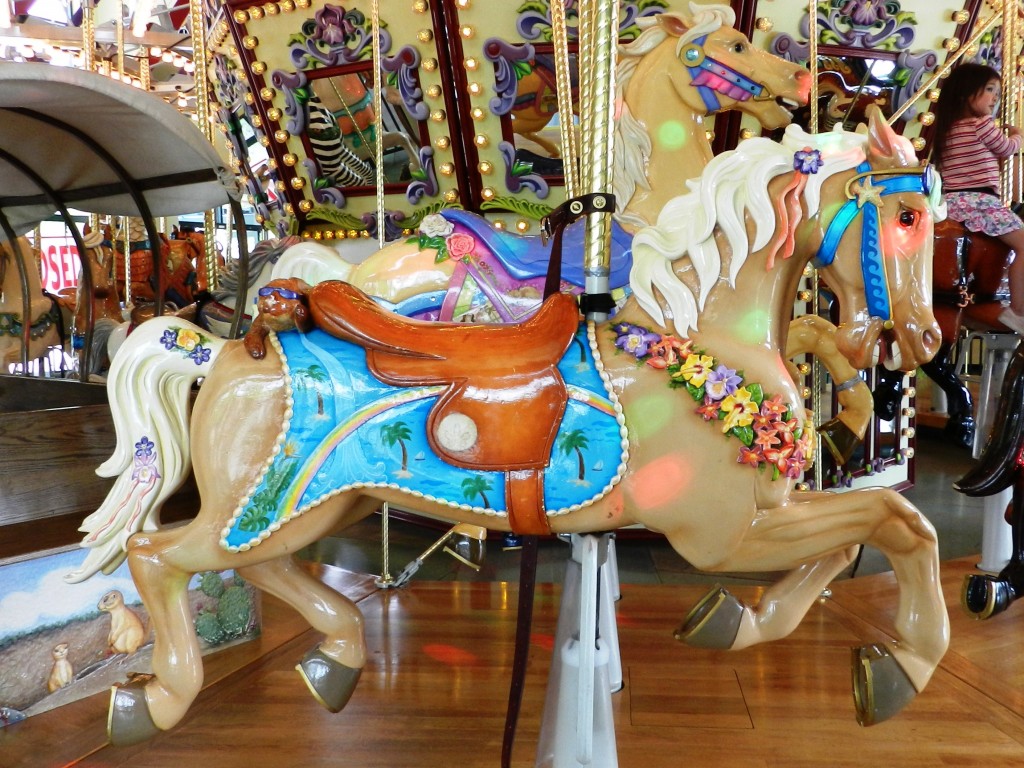» posted on Sunday, June 3rd, 2012 by Linda Lou Burton
Elephant DNA
 Linda Burton posting from Salem, Oregon – Arturo was chopping on the block in his red official carver’s apron. “Don’t you need goggles?” I asked. “Not with chunks this big,” Arturo laughed. “But yes, if I’m using the bandsaw.” I’m standing in the Carving Room at the Salem Riverfront Carousel, a room that is crowded at the moment with volunteers, carving tools, chunks of wood, and detailed drawings of elephants and frogs. I’d found the place by accident; Olessya had brought her siblings to ride the carousel; when I asked for directions to the place she told me there was carving going on today. “Go to the second door,” she said. Irene opened the door and let me in. “The carousel animals are hand-carved,” she explained, “all by volunteers. Right now we’re carving new animals, so we can change them out each month. We’ll have special ones throughout the seasons, too. That way there will always be something new.” A would-be elephant took up the center of the room, that’s what Arturo was working on today. “So this will be an elephant?” I rubbed my hand against the wood. “It doesn’t smell like an elephant, or look like much of one either, right now. It doesn’t even have a trunk.”
Linda Burton posting from Salem, Oregon – Arturo was chopping on the block in his red official carver’s apron. “Don’t you need goggles?” I asked. “Not with chunks this big,” Arturo laughed. “But yes, if I’m using the bandsaw.” I’m standing in the Carving Room at the Salem Riverfront Carousel, a room that is crowded at the moment with volunteers, carving tools, chunks of wood, and detailed drawings of elephants and frogs. I’d found the place by accident; Olessya had brought her siblings to ride the carousel; when I asked for directions to the place she told me there was carving going on today. “Go to the second door,” she said. Irene opened the door and let me in. “The carousel animals are hand-carved,” she explained, “all by volunteers. Right now we’re carving new animals, so we can change them out each month. We’ll have special ones throughout the seasons, too. That way there will always be something new.” A would-be elephant took up the center of the room, that’s what Arturo was working on today. “So this will be an elephant?” I rubbed my hand against the wood. “It doesn’t smell like an elephant, or look like much of one either, right now. It doesn’t even have a trunk.”
 “Oh, there’s an elephant inside,” John laughed. “Here’s the trunk,” he said, holding up a curving piece of wood, “and that’s what it will look like when we’re done.” He pointed to the wall, where large detailed drawings of an elephant were taped; a side view with saddle, and carousel pole; a front view with a line showing where the curving piece would be attached. A smaller rendering in color was propped on the table, amidst the notes and notebooks, and a basket full of chips, neatly sealed in plastic bags. “That’s elephant DNA,” Irene explained, and handed me a bag. “Please take it home, it’s yours to keep. When children come to carve, we let them keep their chips. They love having their own elephant DNA.” Well I’ll be darned, that’s cute as pie!
“Oh, there’s an elephant inside,” John laughed. “Here’s the trunk,” he said, holding up a curving piece of wood, “and that’s what it will look like when we’re done.” He pointed to the wall, where large detailed drawings of an elephant were taped; a side view with saddle, and carousel pole; a front view with a line showing where the curving piece would be attached. A smaller rendering in color was propped on the table, amidst the notes and notebooks, and a basket full of chips, neatly sealed in plastic bags. “That’s elephant DNA,” Irene explained, and handed me a bag. “Please take it home, it’s yours to keep. When children come to carve, we let them keep their chips. They love having their own elephant DNA.” Well I’ll be darned, that’s cute as pie! 
Watching the carving is interesting stuff; hearing about the project overall, and how the carousel came to be, is fascinating. It started back in 1996, when Hazel Patton took a trip to visit family in Missoula, Montana. There she rode the first old-world-style carousel built in the US since the Great Depression. She thought it was beautiful; but she was more impressed by how the community in Missoula had come together to create it. “We can do this in Salem, too” she believed.
She was right. A Dream Team was formed to organize the effort; $2.1 million was raised; and the carving began. By the 10th anniversary of its June 2001 opening, a group called the “Devoted Dozen” – seven men and five women – had given over 27,220 hours of volunteer time; over 145,000 hours were racked up by more than 1,600 volunteers doing everything from carving to wiping saddles.
This is not a carnival ride, they emphasize. It’s a work of art, and an asset for Salem; an asset with a mission – to enhance the quality of life in the Willamette Valley by “invigorating community cohesiveness, fostering cultural and educational opportunities, creating a living history, and increasing tourism.”
 And it’s magic. If you think riding a carousel is fun (and we know it is!), be assured that making one is even more exciting. “I was hooked after my first carving class,” Dick told me. “And I haven’t stopped since.” You can get involved with the creative process in beginner carving classes Tuesday, Wednesday or Thursday, call to set up. Help to make an elephant, or a frog. The drawing of Mister Hopkins, who is under construction too, shows he’ll be 40” long, 11 5/8” wide, will have a diploma in his pocket, a dragonfly on his shirt, and love birds in a nest tucked underneath. Adorable!
And it’s magic. If you think riding a carousel is fun (and we know it is!), be assured that making one is even more exciting. “I was hooked after my first carving class,” Dick told me. “And I haven’t stopped since.” You can get involved with the creative process in beginner carving classes Tuesday, Wednesday or Thursday, call to set up. Help to make an elephant, or a frog. The drawing of Mister Hopkins, who is under construction too, shows he’ll be 40” long, 11 5/8” wide, will have a diploma in his pocket, a dragonfly on his shirt, and love birds in a nest tucked underneath. Adorable! 
Support the Salem Riverfront Carousel by volunteering your time, talent and financial support. Carve, adopt or sponsor a new animal; call 503-540-0374 and earn your own elephant DNA.
